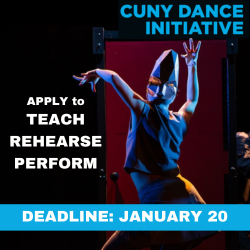Dance. Workforce. Resilience. Initiative
Thursday, July 21, 2022
Census Data Updates

DATA ON INDIVIDUAL WORKERS
Page Updated November 18, 2022 2:00 p.m.
[[thermometer date="2022-12-15" goal="1500" completed="1136" days_remaining_label="Days to Go" progress_label="to Goal" completed_label="Surveys Completed" goal_label="Response Goal"]] *
Top Key Takeaways (As of October 31, 2022)
The Census is not yet representative of the industry’s dance workers and needs engagement from:
- Administrators, leadership, production and other people who support dance making and dance education.
- Dance workers Bronx, Queens, Staten Island, Long Island, Upstate and New Jersey
- ALAANA, Immigrant, LGBTQIA+, Gen X and older and gender identities other than Ciswoman/woman
Facts & Figures
- 70% of responding dance workers reside in Manhattan or Brooklyn
- 7% identify as disabled
- 49% identify as ALAANA
- 60% identify as Cis-woman or woman
- 50% identify as heterosexual or straight
- 61% are Millennials
- 18% are immigrants born outside of the United States
![]()
![]()
Quotes
“Dance has been my life. It has been the source of great happiness for me. It was what I was meant to do. And I am so lucky to have had a life where I knew this and could pursue this dream.”
“...As dance archivist, I engage with many dance elders who are in dire shape financially and have very little support and resources…to fall back on. I'm often fearful that I'll end up in a similar situation as I age in the field.”
“I worked in the industry for 10+ years…I got tired of seeing [abusive] behavior excused and no real changes to correct systemic problems...low pay, terrible working conditions, and long hours.”
DATA ON ORGANIZED ENTITIES
Page Updated November 18, 2022 2:00 p.m.
[[thermometer date="2022-12-15" goal="425" completed="253" days_remaining_label="Days to Go" progress_label="to Goal" completed_label="Surveys Completed" goal_label="Response Goal"]] *
Top Key Takeaways
The Census is not yet representative of the sector and needs engagement from:
- Organizations, businesses, fiscally-sponsored groups and sole proprietors
- Entities with budgets of more than $100,000
- Entities that support dance but do not directly produce or present dance programming
- Entities outside of Manhattan
Facts & Figures
- 70% of responding entities produce dance programming (including dance companies)
- 70% have budgets of less than $100,000
- 46% are located in Manhattan
- 58% are non-profit organizations, another 20% are fiscally sponsored
- 40% classify their financial health as weak or very weak
- 40% do not have a formal DEI policy
- 30% do not provide accessibility accommodations
![]()
![]()
Quotes
“It is important to find LONG TERM solutions. We have to pay "salaries" to dancers and all the team around them. We have to keep audiences engaged and aware. We have to organize a dancers union…”
“My group is funded by jobs I take outside the field of dance.”
“There are not enough grants, not enough long-term support. Commissions are too low and not enough. Space rentals are too expensive.”
*Response goals are set as 25% of the known universe of dance workers (approx. 6000) and organized dance entities (approx. 1700). That universe has been defined using data sources from US, New York and New York City governments and publications as well as relevant service organizations including fiscal sponsors.



